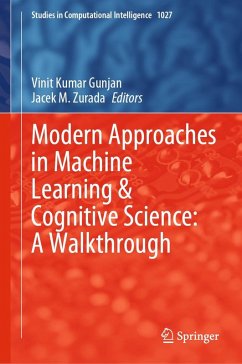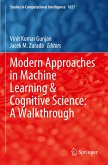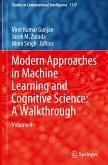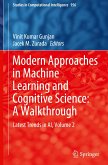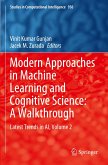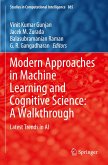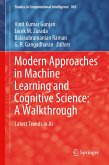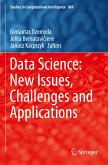Modern Approaches in Machine Learning & Cognitive Science: A Walkthrough
Herausgegeben:Gunjan, Vinit Kumar; Zurada, Jacek M.
Modern Approaches in Machine Learning & Cognitive Science: A Walkthrough
Herausgegeben:Gunjan, Vinit Kumar; Zurada, Jacek M.
- Gebundenes Buch
- Merkliste
- Auf die Merkliste
- Bewerten Bewerten
- Teilen
- Produkt teilen
- Produkterinnerung
- Produkterinnerung
This book provides a systematic and comprehensive overview of AI and machine learning which have got the ability to identify patterns in large and complex data sets. A remarkable success has been experienced in the last decade by emulating the brain computer interface. It presents the cognitive science methods and technologies that have played an important role at the core of practical solutions for a wide scope of tasks between handheld apps, industrial process control, autonomous vehicles, environmental policies, life sciences, playing computer games, computational theory, and engineering…mehr
Andere Kunden interessierten sich auch für
![Modern Approaches in Machine Learning & Cognitive Science: A Walkthrough Modern Approaches in Machine Learning & Cognitive Science: A Walkthrough]() Modern Approaches in Machine Learning & Cognitive Science: A Walkthrough145,99 €
Modern Approaches in Machine Learning & Cognitive Science: A Walkthrough145,99 €![Modern Approaches in Machine Learning and Cognitive Science: A Walkthrough Modern Approaches in Machine Learning and Cognitive Science: A Walkthrough]() Modern Approaches in Machine Learning and Cognitive Science: A Walkthrough117,99 €
Modern Approaches in Machine Learning and Cognitive Science: A Walkthrough117,99 €![Modern Approaches in Machine Learning and Cognitive Science: A Walkthrough Modern Approaches in Machine Learning and Cognitive Science: A Walkthrough]() Modern Approaches in Machine Learning and Cognitive Science: A Walkthrough132,99 €
Modern Approaches in Machine Learning and Cognitive Science: A Walkthrough132,99 €![Modern Approaches in Machine Learning and Cognitive Science: A Walkthrough Modern Approaches in Machine Learning and Cognitive Science: A Walkthrough]() Modern Approaches in Machine Learning and Cognitive Science: A Walkthrough192,59 €
Modern Approaches in Machine Learning and Cognitive Science: A Walkthrough192,59 €![Modern Approaches in Machine Learning and Cognitive Science: A Walkthrough Modern Approaches in Machine Learning and Cognitive Science: A Walkthrough]() Modern Approaches in Machine Learning and Cognitive Science: A Walkthrough117,99 €
Modern Approaches in Machine Learning and Cognitive Science: A Walkthrough117,99 €![Modern Approaches in Machine Learning and Cognitive Science: A Walkthrough Modern Approaches in Machine Learning and Cognitive Science: A Walkthrough]() Modern Approaches in Machine Learning and Cognitive Science: A Walkthrough129,99 €
Modern Approaches in Machine Learning and Cognitive Science: A Walkthrough129,99 €![Data Science: New Issues, Challenges and Applications Data Science: New Issues, Challenges and Applications]() Data Science: New Issues, Challenges and Applications117,99 €
Data Science: New Issues, Challenges and Applications117,99 €-
-
-
This book provides a systematic and comprehensive overview of AI and machine learning which have got the ability to identify patterns in large and complex data sets. A remarkable success has been experienced in the last decade by emulating the brain computer interface. It presents the cognitive science methods and technologies that have played an important role at the core of practical solutions for a wide scope of tasks between handheld apps, industrial process control, autonomous vehicles, environmental policies, life sciences, playing computer games, computational theory, and engineering development. The chapters in this book focuses on audiences interested in machine learning, cognitive and neuro-inspired computational systems, their theories, mechanisms, and architecture, which underline human and animal behaviour, and their application to conscious and intelligent systems. In the current version, it focuses on the successful implementation and step-by-step explanation of practical applications of the domain. It also offers a wide range of inspiring and interesting cutting-edge contributions on applications of machine learning and cognitive science such as healthcare products, medical electronics, and gaming.
Produktdetails
- Produktdetails
- Studies in Computational Intelligence 1027
- Verlag: Springer / Springer International Publishing / Springer, Berlin
- Artikelnr. des Verlages: 978-3-030-96633-1
- 1st edition 2022
- Seitenzahl: 572
- Erscheinungstermin: 23. April 2022
- Englisch
- Abmessung: 241mm x 160mm x 37mm
- Gewicht: 1016g
- ISBN-13: 9783030966331
- ISBN-10: 303096633X
- Artikelnr.: 63309267
- Herstellerkennzeichnung Die Herstellerinformationen sind derzeit nicht verfügbar.
- Studies in Computational Intelligence 1027
- Verlag: Springer / Springer International Publishing / Springer, Berlin
- Artikelnr. des Verlages: 978-3-030-96633-1
- 1st edition 2022
- Seitenzahl: 572
- Erscheinungstermin: 23. April 2022
- Englisch
- Abmessung: 241mm x 160mm x 37mm
- Gewicht: 1016g
- ISBN-13: 9783030966331
- ISBN-10: 303096633X
- Artikelnr.: 63309267
- Herstellerkennzeichnung Die Herstellerinformationen sind derzeit nicht verfügbar.
Vinit Kumar Gunjan is Associate Professor in Department of Computer Science & Engineering and Dean of Academic affairs at CMR Institute of Technology Hyderabad (Affiliated to Jawaharlal Nehru Technological University, Hyderabad). He is an active researcher; he has published research papers in IEEE, Elsevier and Springer conferences, authored several books and edited volumes of Springer series, most of which are indexed in SCOPUS database. He was awarded with the prestigious Early Career Research Award in the year 2016 by Science Engineering Research Board, Department of Science & Technology, Government of India. He is Senior Member of IEEE, active Volunteer of IEEE Hyderabad Section, and 2021 Additional Secretary; he is 2021 Vice Chairman¿IEEE Computational Intelligence Society; he is volunteered in the capacity of Treasurer, Secretary and Chairman of IEEE Young Professionals Affinity Group and IEEE Computer Society. He was involved as organizer in many technical and non-technical workshops, seminars and conferences of IEEE and Springer. During the tenure, he had an honour of working with top leaders of IEEE and was awarded with outstanding IEEE Young Professional Award in 2017 by IEEE Hyderabad Section. Jacek M. Zurada is Professor of Electrical and Computer Engineering and Director of the Computational Intelligence Laboratory at the University of Louisville, Kentucky, USA, where he served as Department Chair and Distinguished University Scholar. He received his M.S. and Ph.D. degrees (with distinction) in electrical engineering from the Technical University of Gdansk, Poland. He has published over 420 journal and conference papers in neural networks, deep learning, computational intelligence, data mining, image processing, and VLSI circuits. He has authored or co-authored three books, including the pioneering text Introduction to artificial neural systems, co-edited the volumes computational intelligence: imitating life, knowledge-based neurocomputing, and co-edited twenty volumes in Springer Lecture Notes on Computer Science. In addition to his pioneering neural networks textbook, his most recognized achievements include an extension of complex-valued neurons to associative memories and perception networks; sensitivity concepts applied to multilayer neural networks; application of networks to clustering, biomedical image classification, and drug dosing; blind sources separation; and rule extraction as a tool for prediction of protein secondary structure.
Detection of Parkinsons disease using machine learning.- East Meets West: Sentiment Analysis for Election Prediction.- Performance of Machine Learning Algorithms to Predict Right Mutual Funds of Indian Companies.- Stock Market Prediction by Incorporating News Sentiments Using Bert.- Natural selection based recommendation system for personalization of point of interests using Linguistic techniques.- Deep Learning Techniques for COVID-19 Pandemic: - Application of Transfer Learning in Deep Networks.- Comparison of Various Segmentation Techniques in Diabetic Retinopathy-A Review.- Review on insight into elliptic curve cryptography.- Design and implementation of identifying points on elliptic curve efficiently using Java.- Multilingual Information Retrieval Chatbot.- Using Telematics Data For Traffic And Road Mishaps Prediction And Analysis Of Driver Behavior.- Prediction of Diabetes using various Feature Selection and Machine Learning Paradigms.- Study and Survey of Depression Analysis and Prediction in Perspective of Machine Learning Approach.- Matching Pattern in DNA Sequences Using Machine Learning Approach Based on K-Mer Function.- Prediction of Movie Genres Based on its Synopsis and Title Using BiLSTM.- Blockchain based cryptocurrencies' fundamental and its comparison.- Hierarchical Deep Learning Network based Framework for Disaster Event Detection.- Agronomy prediction by stream fractal clustering on geo map in real-time.- Isolated Microgrid Combined Economic Emission Dispatch Using Jellyfish Search Optimizer.- Analysis of Multiple Component Based CNN for Similar Citrus Species Classification.- Facial Recognition using Image Encoding (Alternate method).- An Innovative Rapid Cursor Control System using Eye Movement for a Physically Challenged Person.- Stroke Awareness ChatBot Assistant with Stroke Risk Prediction using Demographic Data.- Object Detection Using SSD MobileNet on Indian Dataset.- Machine Learning Algorithms for DDOS Attack Detection in Cybersecurity.- Signature Extraction from Bilingual Document Images Using Blobs Method.- A Review of Routing Algorithms in Internet of Things.- Early Identification of Rumors in social media: A Survey.- Music Recommendation System using Speech-Based Emotion Recognition.- Safety and Prevention Measure to Reduce the Spread of Corona Virus at Places of Mass Human Navigation-A precautious way to Protect from Covid-19.- Contaminant sole disinfectant - A methodical approach to reduce the spread of COVID.- Effective Monitoring of Onion Production Stored in Ware House to Reduce the Commercial Commodity Wastage and Improve Reutilization.- Covid-19 Tracker App Using Android Based Application Program to track the Covid-19 cases all over the countries.- Self defence system for Women Safety with Location Tracking and SMS alerting through GPS & GSM Networks.- Raspberry Pi Based Crowd and Facemask Detection with Email and Message Alert.- Driver State Analysis Using Ai to Avoid Road Accidents.- Person identity andgender estimation using Gait Biometrics: A Review.- Design and Development of a CNN model based Android application for detection of plant leaf diseases in-home grown plants in Saudi Arabia.- Melanoma Skin Segmentation Process Using PCA and morphological methods.- Safety Locker System with Image Identification by Using Iot.- Simultaneous scheduling of machines, tools and jobs in multimachine flexible manufacturing system by using Black Widow Optimization algorithm.-Design and Development of Voice and Gesture Controlled Multitasking Robot.- Novel Method for the Segmentation of Brain Images Using the FCM Clustering Approach As Well as Rough Set.- IoT Based Live Monitoring Public Transportation Security System By Using Raspberry Pi, GSM& GPS.- Integrating of Aquaculture and Agriculture by using IoT Technology. Study of Mechanical Properties on Hybrid Fibre Reinforced Concrete.- Experimental Investigation on Effect of Magnetic Water on Concrete by Partial Replacement of Cement with Steel Slag and Quartz Powder.- ENHANCED SECURITY FOR SMART Door Using Biometrics And Otp.- An Enhanced Image Processing model for earlier Detection and Analysis of Diabetic Foot Hyperthermia through Cognitive approach.- Intelligent Greenhouse Monitoring and Automatic Controlling Protocol by using Python on Raspberry Pi.- Design of Smart Classroom In Educational Institutes for Smart And A Sustainable Campus Based on Internet Of Things.
Detection of Parkinsons disease using machine learning.- East Meets West: Sentiment Analysis for Election Prediction.- Performance of Machine Learning Algorithms to Predict Right Mutual Funds of Indian Companies.- Stock Market Prediction by Incorporating News Sentiments Using Bert.- Natural selection based recommendation system for personalization of point of interests using Linguistic techniques.- Deep Learning Techniques for COVID-19 Pandemic: - Application of Transfer Learning in Deep Networks.- Comparison of Various Segmentation Techniques in Diabetic Retinopathy-A Review.- Review on insight into elliptic curve cryptography.- Design and implementation of identifying points on elliptic curve efficiently using Java.- Multilingual Information Retrieval Chatbot.- Using Telematics Data For Traffic And Road Mishaps Prediction And Analysis Of Driver Behavior.- Prediction of Diabetes using various Feature Selection and Machine Learning Paradigms.- Study and Survey of Depression Analysis and Prediction in Perspective of Machine Learning Approach.- Matching Pattern in DNA Sequences Using Machine Learning Approach Based on K-Mer Function.- Prediction of Movie Genres Based on its Synopsis and Title Using BiLSTM.- Blockchain based cryptocurrencies' fundamental and its comparison.- Hierarchical Deep Learning Network based Framework for Disaster Event Detection.- Agronomy prediction by stream fractal clustering on geo map in real-time.- Isolated Microgrid Combined Economic Emission Dispatch Using Jellyfish Search Optimizer.- Analysis of Multiple Component Based CNN for Similar Citrus Species Classification.- Facial Recognition using Image Encoding (Alternate method).- An Innovative Rapid Cursor Control System using Eye Movement for a Physically Challenged Person.- Stroke Awareness ChatBot Assistant with Stroke Risk Prediction using Demographic Data.- Object Detection Using SSD MobileNet on Indian Dataset.- Machine Learning Algorithms for DDOS Attack Detection in Cybersecurity.- Signature Extraction from Bilingual Document Images Using Blobs Method.- A Review of Routing Algorithms in Internet of Things.- Early Identification of Rumors in social media: A Survey.- Music Recommendation System using Speech-Based Emotion Recognition.- Safety and Prevention Measure to Reduce the Spread of Corona Virus at Places of Mass Human Navigation-A precautious way to Protect from Covid-19.- Contaminant sole disinfectant - A methodical approach to reduce the spread of COVID.- Effective Monitoring of Onion Production Stored in Ware House to Reduce the Commercial Commodity Wastage and Improve Reutilization.- Covid-19 Tracker App Using Android Based Application Program to track the Covid-19 cases all over the countries.- Self defence system for Women Safety with Location Tracking and SMS alerting through GPS & GSM Networks.- Raspberry Pi Based Crowd and Facemask Detection with Email and Message Alert.- Driver State Analysis Using Ai to Avoid Road Accidents.- Person identity andgender estimation using Gait Biometrics: A Review.- Design and Development of a CNN model based Android application for detection of plant leaf diseases in-home grown plants in Saudi Arabia.- Melanoma Skin Segmentation Process Using PCA and morphological methods.- Safety Locker System with Image Identification by Using Iot.- Simultaneous scheduling of machines, tools and jobs in multimachine flexible manufacturing system by using Black Widow Optimization algorithm.-Design and Development of Voice and Gesture Controlled Multitasking Robot.- Novel Method for the Segmentation of Brain Images Using the FCM Clustering Approach As Well as Rough Set.- IoT Based Live Monitoring Public Transportation Security System By Using Raspberry Pi, GSM& GPS.- Integrating of Aquaculture and Agriculture by using IoT Technology. Study of Mechanical Properties on Hybrid Fibre Reinforced Concrete.- Experimental Investigation on Effect of Magnetic Water on Concrete by Partial Replacement of Cement with Steel Slag and Quartz Powder.- ENHANCED SECURITY FOR SMART Door Using Biometrics And Otp.- An Enhanced Image Processing model for earlier Detection and Analysis of Diabetic Foot Hyperthermia through Cognitive approach.- Intelligent Greenhouse Monitoring and Automatic Controlling Protocol by using Python on Raspberry Pi.- Design of Smart Classroom In Educational Institutes for Smart And A Sustainable Campus Based on Internet Of Things.

